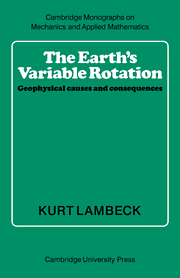Book contents
11 - Paleorotation
Published online by Cambridge University Press: 06 October 2009
Summary
Polar wander
The concept of polar wander, the large-scale wandering of the Earth's axis of rotation throughout geological time, goes back more than 100 yr and has its origin in observations of fossil plant and animal distributions, and in the scars, tillites and moraines of past glaciations. For example, the discovery that a subtropical climate existed in Spitsbergen at a time when Central and Southern Europe were subject to a tropical climate and when extensive glaciations occurred in Southern Africa, led to the conclusion that, in the western hemisphere, the Carboniferous equator must have lain far to the north of the present equator. A further degree of freedom to the interpretation of the paleontological and paleoclimatic data was introduced by Wegener and by F. B. Taylor with their concept of continental drift, in which the continents are postulated to have moved relative to each other over large distances throughout geologic time. For lack of convincing observational evidence and for an absence of compelling theoretical arguments, the notions of polar wander and of continental drift both remained at the periphery of scientific responsibility until rescued from this limbo by two important paleomagnetic discoveries: that large changes have occurred in the mean direction of the geomagnetic field and that this field has periodically reversed itself. Evidence for both changes is found throughout the Phanerozoic and Proterozoic, permitting some conclusions to be drawn about the reality of drift and wander for much of the geologic record.
- Type
- Chapter
- Information
- The Earth's Variable RotationGeophysical Causes and Consequences, pp. 342 - 400Publisher: Cambridge University PressPrint publication year: 1980

